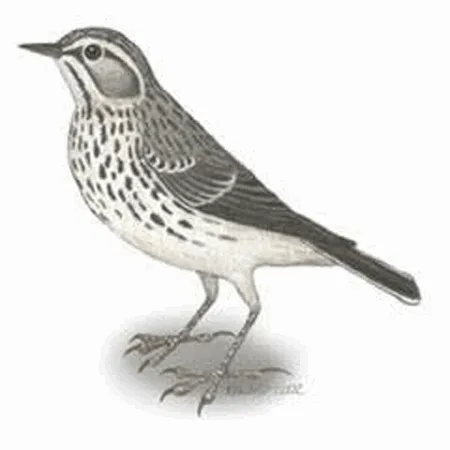
Berthelots Pipit
[order] PASSERIFORMES | [family] Motacillidae | [latin] Anthus berthelotii | [UK] Berthelots Pipit | [FR] Pipit de Berthelot | [DE] | [ES] Bisbita Caminero | [NL] Berthelots Pieper
Subspecies
| Genus | Species | subspecies | Breeding Range | Breeding Range 2 | Non Breeding Range |
| Anthus | berthelotii | AF | Madeira, Canary Islands | ||
| Anthus | berthelotii | berthelotii | |||
| Anthus | berthelotii | madeirensis |
Physical charateristics
A brownish bird with darker stripes that walks and runs a lot. It is a subspecies of the species from the Canaries (Anthus berthelotii berthelotii), being distinguished by its longer beak. Distinguishing between the sexes is not easy because there is only a slight variation in the plumage.
Listen to the sound of Berthelots Pipit
[audio:http://www.aviflevoland.nl/sounddb/B/Berthelots Pipit.mp3]
Copyright remark: Most sounds derived from xeno-canto
| wingspan min.: | 21 | cm | wingspan max.: | 24 | cm |
| size min.: | 14 | cm | size max.: | 16 | cm |
| incubation min.: | 0 | days | incubation max.: | 0 | days |
| fledging min.: | 0 | days | fledging max.: | 0 | days |
| broods: | 1 | eggs min.: | 2 | ||
| eggs max.: | 5 |
Range
Africa : Madeira, Canary Islands
Habitat
Mostly island habitats; prefers dry, open areas (including rocky plains and slopes) with bushes, grass, and herbaceous vegetation; also open grasslands, cultivation, vine-clad slopes, dunes, areas of volcanic rock, and open pine forests.
Reproduction
Monogamous; breeds January through August. Nest is a cup of stems, lined hair, wool and feathers; on ground under low plant, bushes or stone; female builds. Lays two to five eggs. Possibly double-brooded.
Feeding habits
Eats insects and seeds. Forages on the ground, climbing over small plants.
Conservation
Although this species may have a restricted range, it is not believed to approach the thresholds for Vulnerable under the range size criterion (Extent of Occurrence <20,000 km2 combined with a declining or fluctuating range size, habitat extent/quality, or population size and a small number of locations or severe fragmentation). The population trend appears to be stable, and hence the species does not approach the thresholds for Vulnerable under the population trend criterion (>30% decline over ten years or three generations). The population size is very large, and hence does not approach the thresholds for Vulnerable under the population size criterion (<10,000 mature individuals with a continuing decline estimated to be >10% in ten years or three generations, or with a specified population structure). For these reasons the species is evaluated as Least Concern.
Anthus berthelotii is endemic to Europe, where its entire global range is confined to
the Canary Islands and Madeira. Its breeding population is relatively small (probably
<100,000 pairs), although recent data on the size of the Madeira population were
not available. Populations on both island groups were stable between 1970-1990,
and although their trends during 1990-2000 were not known, there was no evidence
to suggest that the species declined.

Migration
Endemic species on canary islands. Big part of European individuals: non migratory
Distribution map

